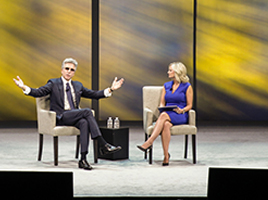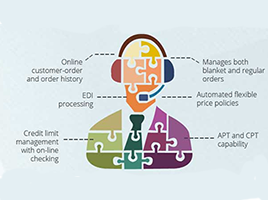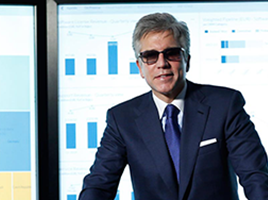
Nothing screams people, passion, and purpose like a thunderous video presentation — involving live acrobatics and tribal drumming — at the MGM Park Theater at SuccessConnect in Las Vegas this week. This one-of-a-kind keynote presentation was clearly designed to make the more than 4,000 HR professionals in attendance sit up and pay attention to a major movement happening in the workforce today, a “ human revolution” that’s now banging on their door.

A human revolution, according to Greg Tomb, president of SAP SuccessFactors, “is when your employees voices are heard loud and proud” while ensuring your entire workforce is motivated. The heart of the human revolution “beats to the speed of business,” and Tomb shared some astounding examples with the SuccessConnect audience to back his claims:
- Millennials and generation Z will represent more than 50 percent of the workforce by 2020.This largest segment of the workforce is used to having tech integrated into their everyday lives, which they also expect in the workplace. “We’ve got to give then the type of environment they can be successful in,” said Tomb.
- 44 percent of the workforce spend occurs outside of the employee base and it keeps growing. “The ability to harness that external workforce is paramount if companies are going to grow and succeed in the future,” said Tomb.
- 35 percent of employees say their jobs are hurting their physical and/or emotional health.“Think about the positive impact on your business if we can improve mentally and physically the well-being of every single employee in your company,” said Tomb.
- A recent Korn Ferry study says a global talent deficit could surpass 85.2 million workers by 2030, costing $8.5 trillion in revenue potential. “We know today it’s hard to compete for talent,” said Tomb. “Think how hard it will be in five to 10 years. Companies that invest in attracting and retaining and re-tooling their talent will be the winners.”
To further flesh out the human revolution narrative, and its undeniable impact on global businesses, Tomb invited SAP Chief Marketing Officer Alicia Tillman and SAP CEO Bill McDermott onto the stage. The duo played off each other well, leading the audience through a fascinating and frank discussion.
When McDermott joined SAP as CEO in 2010 he had a vision to help make the world run better and improve people’s lives.
“If we’re going to be great, we have to take on the world’s biggest challenges because they are also the biggest opportunities,” said McDermott. “How can you possibly be purpose-driven without people at the center of the vision?”
As a result, SAP’s first strategic move into the cloud was the acquisition of SuccessFactors in 2011.
Connection to Company Culture
According to McDermott, everything you do in a company has to connect with the people you serve outside the company.
“The culture of a company is everything. It’s what drives innovation, great products, amazing services, and makes leaders understand the power of hiring the very best people because you have to make the perfect link between the consumer experience and the employee experience.”
McDermott believes the employee experience and consumer experience are similar, with every person in the company holding an incredibly important role in solving that customer’s requirement.
“Unfortunately, many companies have gotten big, complex and we’ve lost the humanity — the people power — because silos, walls, and org charts got in the way.”
McDermott urged the audience to think about a seamless connection between the ultimate customer experience and how an employee understands their role. To make this work, the employee experience, the passion for people, and the link to their individual goals is essential in the achievement of corporate goals. “If you can connect on that goal development and human orientation and their experience in the workplace, it could change the world.”
Looking from the Outside in
Nearly all the experiences taking place outside the company have to be driven from inside the company, according to McDermott. And the only way to ensure this vision comes to life is to have the chief human resources officer and other human capital professionals completely linked to the CEO.
“People have a deep, human need to understand what piece of the puzzle belongs to them and the role they play in ultimately leading their company to greatness,” said McDermott. “The strategy of a company is inextricably linked to the people.”
SAP is leading by example as Stefan Ries, the company’s chief human resources officer, has a seat the table with the CEO and all the top managers, plugged into everything they do. SAP also wanted to make the company younger by one year, every year, and increase its employee retention rate.
An inspired work culture has the power to provide stellar customer service, not just delivering what they want today but what they need five years down the road.
“It’s important to build products and services that the customer may not even know they need yet,” said McDermott. “Once they get them they won’t know how they ever lived without them.”




















